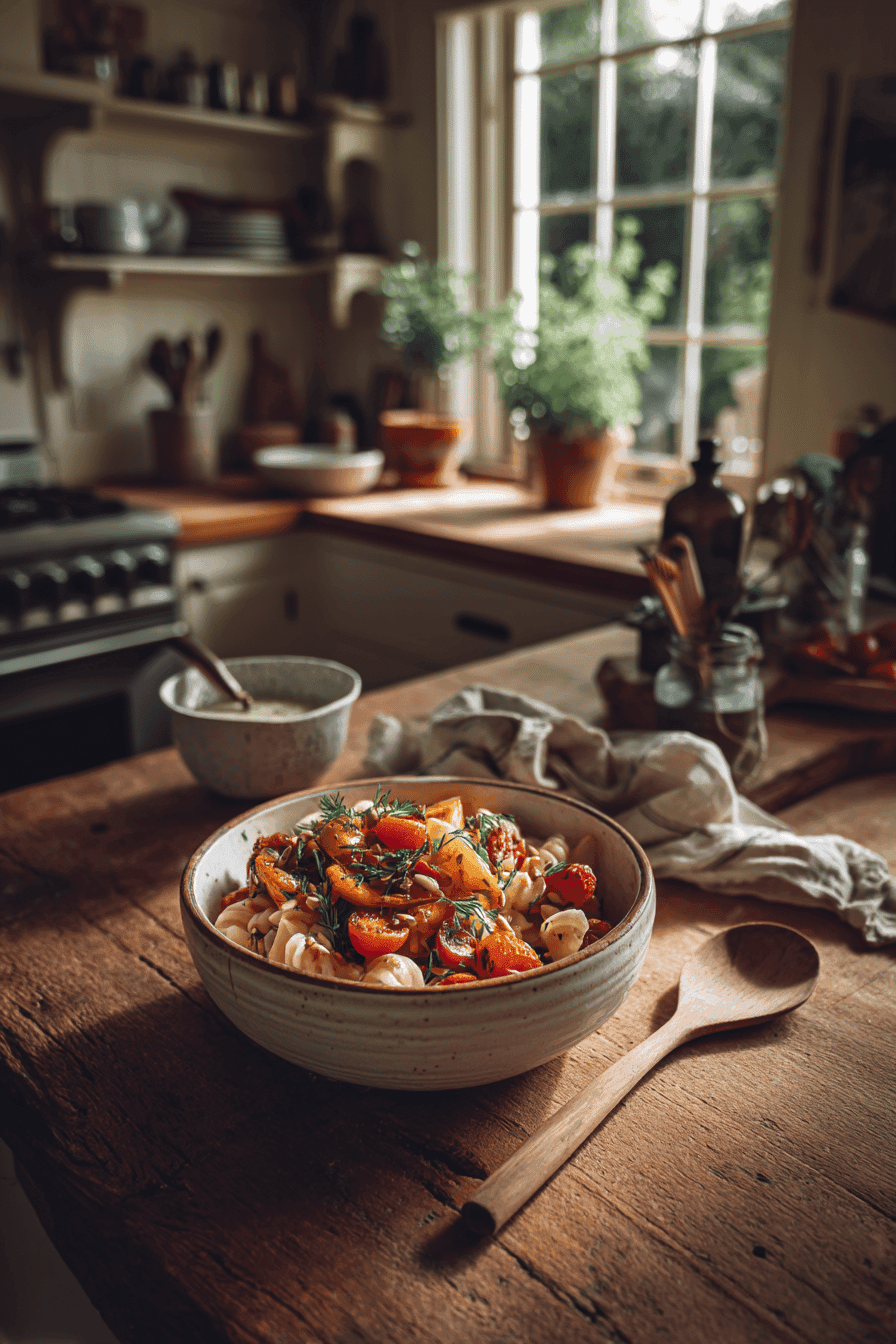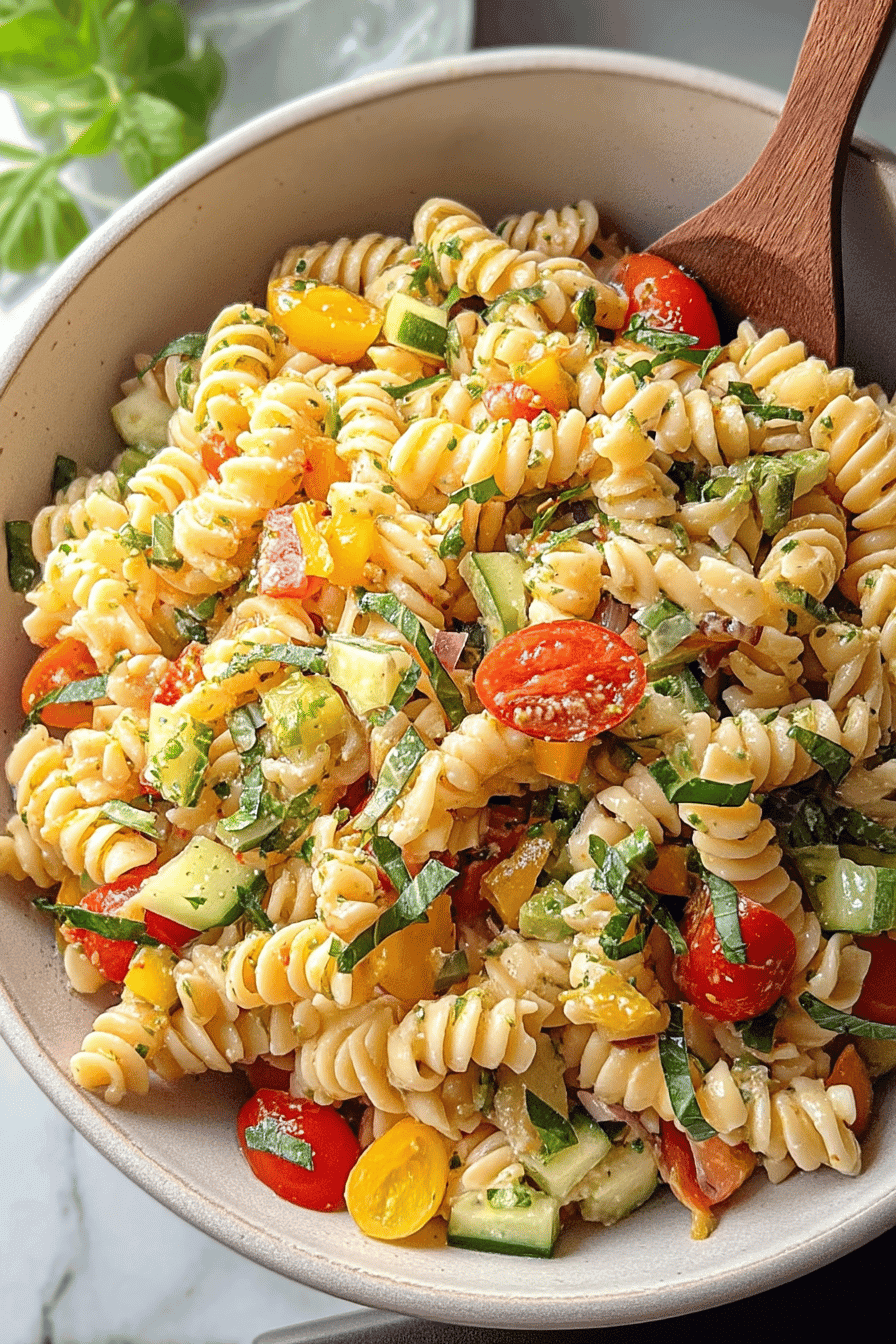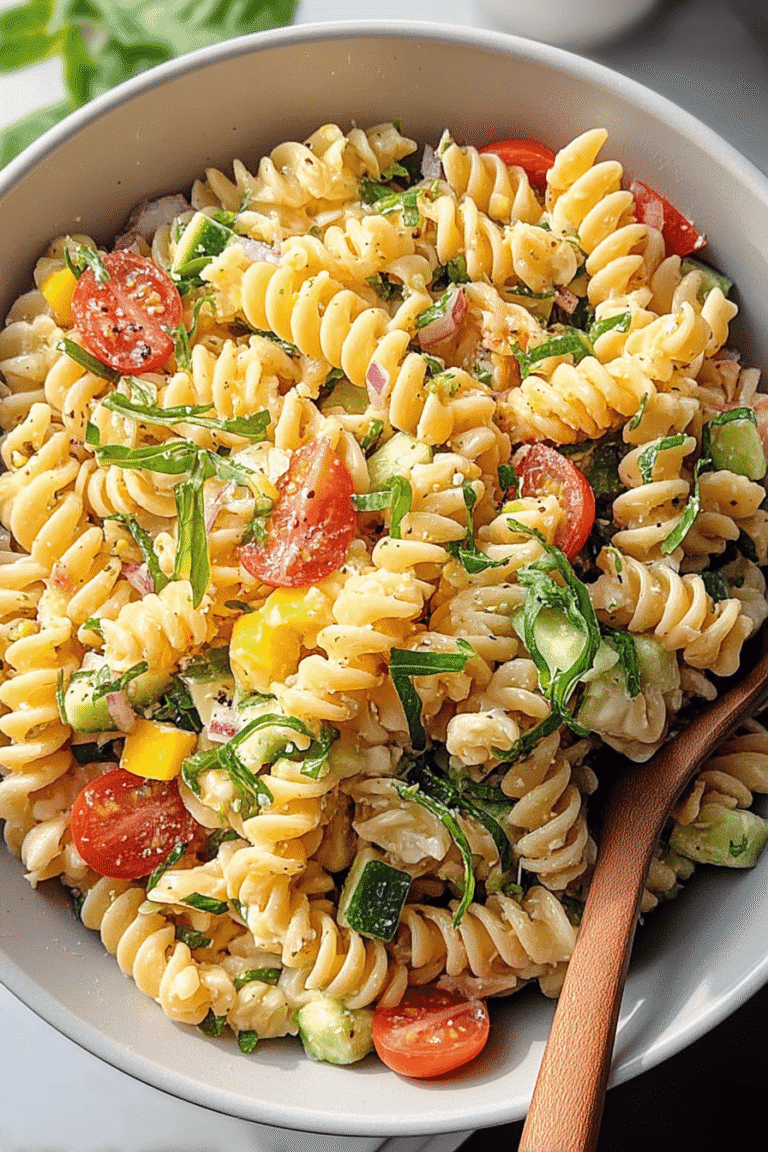Benefits and Advantages of Summer Pasta Salad
Summer pasta salad is an ideal dish for warm weather thanks to its simplicity and versatility. The recipe requires minimal cooking, enabling quick assembly which is perfect for busy days and gatherings. This salad offers a balanced mix of carbohydrates from pasta, fresh vegetables, and protein, supporting a nutritious and satisfying meal. Its refreshing ingredients and light, tangy dressings help maintain hydration and provide essential vitamins and minerals during the hot months.
Moreover, the flexibility of summer pasta salad allows easy customization to accommodate dietary preferences such as vegan or gluten-free diets without compromising taste or texture. Visually, the vibrant colors and varied textures of fresh vegetables and herbs make it an attractive centerpiece for picnics, potlucks, or simple family dinners. These qualities position summer pasta salad as a staple dish that combines healthfulness with crowd-pleasing flavor and convenience.
Its blend of fresh flavors, easy preparation, and adaptability makes summer pasta salad a perfect choice for nutritious and enjoyable meals during warm months.
Jump to:
- Benefits and Advantages of Summer Pasta Salad
- Essential Ingredients for Summer Pasta Salad
- Dietary Substitutions to Customize Your Summer Pasta Salad
- How to Prepare the Perfect Summer Pasta Salad: Step-by-Step Guide
- Mastering Summer Pasta Salad: Advanced Tips and Variations
- How to Store Summer Pasta Salad: Best Practices
- Nutritional Value of Summer Pasta Salad
- FAQs: Frequently Asked Questions About Summer Pasta Salad
- What type of pasta works best for summer pasta salad?
- Can I prepare summer pasta salad ahead of time, and how should I store it?
- How do I keep pasta salad safe to eat at outdoor events like picnics?
- What are good ingredient substitutions to make a vegan or gluten-free pasta salad?
- How can I improve the flavor of less ripe tomatoes in pasta salad?
- Simple and Fresh Pasta Salad Recipes Perfect for Summer Gatherings
- Ingredients
- Instructions
- Last Step:
- Notes
- Nutrition
- Did you make this recipe?
Essential Ingredients for Summer Pasta Salad
- About 1 pound (approximately 450g) short pasta such as fusilli, rotini, penne, or farfalle
- 10 ounces (about 280g) cherry tomatoes, halved
- 1 medium cucumber (Persian or English, thin-skinned, unpeeled), chopped
- 1 cup cooked chickpeas for plant-based protein
- 2 cups arugula or spinach leaves for leafy green flavor
- 4 ounces (113g) feta cheese, crumbled (or mini mozzarella balls as a substitute)
- 1/3 cup toasted pine nuts (alternatives: roasted pistachios, toasted pepitas, sunflower seeds, or slivered almonds)
- Fresh herbs: 1/4 cup chopped parsley, 2 tablespoons chopped basil, 1 tablespoon chopped mint
- Dressing: 1/3 cup extra virgin olive oil, 3 tablespoons fresh lemon juice (or red wine/balsamic vinegar), 1 teaspoon Dijon mustard, 2 cloves garlic minced, 1/4 teaspoon red pepper flakes, 1 teaspoon herbes de Provence or Mediterranean herb blend, salt and pepper to taste
Optional extras include kalamata olives (about 1/2 cup sliced), thinly sliced red onion (1/4 cup), diced bell peppers, or pepperoncini for a Mediterranean twist. Vegan versions can omit feta or replace with olives or sun-dried tomatoes. Using gluten-free pasta makes it accessible to those with gluten intolerance.

Dietary Substitutions to Customize Your Summer Pasta Salad
Summer pasta salad can be easily tailored for various dietary needs:
- Gluten-Free: Use gluten-free pasta made from rice, corn, or legumes to maintain texture and flavor.
- Vegan: Replace feta cheese with plant-based options like olives, sun-dried tomatoes, or omit cheese entirely. Chickpeas and tofu provide plant-based protein.
- Low-Calorie: Substitute pasta with spiralized vegetables such as zucchini or shirataki noodles for lower carb and calorie counts.
- Dairy-Free: Omit cheese or choose dairy-free cheese alternatives; use olive oil-based dressings instead of creamy ones.
- Herbs & Nuts: Experiment with fresh oregano or thyme instead of mint, and swap pine nuts for other toasted nuts or seeds based on preference or allergies.
Using natural herbs and spices enhances flavor without added sodium, accommodating sensitive diets. These simple substitutions preserve the salad’s fresh and vibrant character while making it suitable for a wide audience.
How to Prepare the Perfect Summer Pasta Salad: Step-by-Step Guide
- Cook the Pasta: Boil about 1 pound of short pasta in salted water until slightly past al dente (about 2 minutes longer than package instructions). Drain and toss with olive oil to prevent sticking. Cool to room temperature.
- Prepare Vegetables: Chop 10 ounces cherry tomatoes in halves, 1 medium cucumber into bite-sized pieces, and optionally dice red onions and bell peppers if desired.
- Mix the Dressing: In a bowl, whisk together 1/3 cup extra virgin olive oil, 3 tablespoons fresh lemon juice, 1 teaspoon Dijon mustard, 2 cloves minced garlic, 1/4 teaspoon red pepper flakes, 1 teaspoon herbes de Provence, salt, and freshly ground black pepper.
- Add Protein and Greens: Rinse and drain 1 cup cooked chickpeas. Chop 2 cups of arugula or spinach and add to a large mixing bowl with the pasta and vegetables.
- Combine Ingredients: Pour dressing over the pasta, vegetables, chickpeas, and greens. Toss gently to coat everything evenly.
- Add Cheese and Nuts: Fold in 4 ounces crumbled feta or substitute, and 1/3 cup toasted pine nuts or preferred seeds, reserving half for garnish if desired.
- Add Fresh Herbs: Mix in 1/4 cup chopped parsley, 2 tablespoons chopped basil, and 1 tablespoon chopped mint for bright herbal flavor.
- Chill and Serve: Refrigerate the salad for at least 30 minutes to allow flavors to meld. Just before serving, toss again and sprinkle reserved nuts and herbs for fresh texture and color.
This method results in a flavorful, fresh, and visually appealing pasta salad, perfect for summer entertaining. For optimal pasta cooking techniques, visit How to Cook Pasta Perfectly.

Mastering Summer Pasta Salad: Advanced Tips and Variations
To take your summer pasta salad to the next level, consider a few advanced tips and creative variations that enhance flavor, texture, and visual appeal. Roasting vegetables like bell peppers and cherry tomatoes before adding them brings out a smoky sweetness that deepens the overall taste. Trying different pasta shapes fusilli, rotini, penne, or farfalle can add textural diversity and help capture more dressing and ingredients.
Adding nuts and seeds such as toasted pine nuts, roasted pistachios, or sunflower seeds introduces satisfying crunch and boosts nutritional value. For dressing variety, experiment by incorporating ingredients like balsamic vinegar, fresh grated ginger, or minced garlic, which add complexity and excitement to the simple lemon-olive oil base.
Protein swaps can keep the salad interesting: grilled shrimp, marinated tempeh, or pan-seared tofu provide diverse flavors and textures suitable for omnivores and vegetarians alike. To maintain freshness longer, prepare components separately cook and cool pasta, chop vegetables, and toast nuts and combine just before serving. Using seasonal herbs such as oregano, coriander, or fresh edible flowers can brighten the dish, appealing visually and enhancing aroma.
Subtle ingredient tweaks and thoughtful preparation steps make mastering summer pasta salad a rewarding and palate-pleasing exercise.
How to Store Summer Pasta Salad: Best Practices
Proper storage of summer pasta salad is key to maintaining its vibrant flavors and fresh textures. Always refrigerate the salad in an airtight container and consume within 2 to 3 days for the best taste and safety.
If ingredients were prepared separately, store pasta, vegetables, and dressing in separate containers to prevent sogginess. Avoid freezing the assembled salad, as thawing can cause texture loss and watery components. However, you may freeze cooked pasta or chopped vegetables individually if needed, thawing them in the refrigerator overnight before mixing.
When reheating for serving, it is best to warm protein elements gently if desired, while serving the salad chilled overall to preserve crispness and freshness. To maintain crisp vegetables and herbs, add them shortly before serving rather than during storage. Dress the salad just prior to serving if it must be stored for longer to prevent the pasta from absorbing excess moisture.
Storing components separately and timely combining helps keep summer pasta salad fresh, crisp, and delicious.
Nutritional Value of Summer Pasta Salad
| Nutrient | Typical Amount per Serving | Health Benefits |
|---|---|---|
| Calories | 300–400 kcal | Provides moderate energy suitable for a light meal or side |
| Protein | 10–15 g | Supports muscle maintenance; sourced from chickpeas, chicken, or tofu |
| Carbohydrates | 40–50 g | Primarily from pasta, supplying sustained energy |
| Fat | 8–15 g | Mostly healthy fats from olive oil and nuts |
| Fiber | Varies by vegetable content | Promotes digestion and fullness |
| Vitamins | Vitamins A, C, folate | Derived from fresh vegetables, supporting immune health and vitality |
Low-calorie and gluten-free adaptations maintain similar nutritional balance, making the salad versatile for various dietary needs. For additional details on chickpeas’ nutritional value, see Nutritional Value of Chickpeas.

FAQs: Frequently Asked Questions About Summer Pasta Salad
What type of pasta works best for summer pasta salad?
Can I prepare summer pasta salad ahead of time, and how should I store it?
How do I keep pasta salad safe to eat at outdoor events like picnics?
What are good ingredient substitutions to make a vegan or gluten-free pasta salad?
How can I improve the flavor of less ripe tomatoes in pasta salad?

Simple and Fresh Pasta Salad Recipes Perfect for Summer Gatherings
🌞 This Simple and Fresh Pasta Salad is perfect for summer gatherings, offering a burst of vibrant flavors in every bite!
🥗 Quick and easy to prepare, this salad is a wholesome, nutritious option for picnics, potlucks, or as a light dinner.
- Total Time: 1 hour
- Yield: 6 servings 1x
Ingredients
1 pound (450g) short pasta (fusilli, rotini, penne, or farfalle)
10 ounces (280g) cherry tomatoes, halved
1 medium cucumber (chopped)
1 cup cooked chickpeas
2 cups arugula or spinach
4 ounces (113g) feta cheese crumbled
1/3 cup toasted pine nuts
1/4 cup chopped parsley
2 tablespoons chopped basil
1 tablespoon chopped mint
1/3 cup (80 ml) extra virgin olive oil
3 tablespoons fresh lemon juice
1 teaspoon Dijon mustard
2 cloves garlic, minced
1/4 teaspoon red pepper flakes
1 teaspoon herbes de Provence
Salt and freshly ground black pepper to taste
Instructions
1. Cook the pasta in salted boiling water for 2 minutes beyond al dente. Drain, toss with olive oil, and allow to cool to room temperature.
2. In a large mixing bowl, combine cherry tomatoes, cucumber, chickpeas, arugula, feta cheese, pine nuts, parsley, basil, and mint.
3. In a small bowl, whisk together the olive oil, lemon juice, Dijon mustard, garlic, red pepper flakes, herbes de Provence, salt, and pepper.
4. Pour the dressing over the pasta and vegetable mixture. Toss gently to coat evenly.
5. Chill in the refrigerator for at least 30 minutes to allow flavors to meld.
6. Serve cold, optionally garnished with extra mint leaves and pine nuts.
Last Step:
Please leave a rating and comment letting us know how you liked this recipe! This helps our business to thrive and continue providing free, high-quality recipes for you.Notes
🍝 Cook pasta slightly longer for a tender texture when chilled.
❄️ Allow pasta to cool completely before adding veggies to prevent wilting.
🥜 Add half of the fresh herbs and nuts just before serving to keep them vibrant and crunchy.
- Prep Time: 20 minutes
- Chilling Time: 30 minutes
- Cook Time: 10 minutes
- Category: Salad
- Method: No-Cook
- Cuisine: Mediterranean
- Diet: Vegetarian
Nutrition
- Serving Size: 1 cup
- Calories: 450-580
- Fat: 25 g
- Carbohydrates: 70 g
- Fiber: 5 g
- Protein: 16 g







